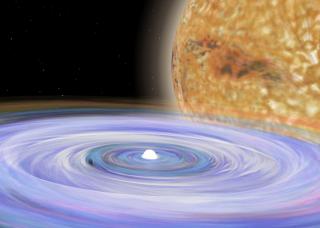Bibcode
Zorotovic, M.; Schreiber, M. R.; Gänsicke, B. T.; Rebassa-Mansergas, A.; Nebot Gómez-Morán, A.; Southworth, J.; Schwope, A. D.; Pyrzas, S.; Rodríguez-Gil, P.; Schmidtobreick, L.; Schwarz, R.; Tappert, C.; Toloza, O.; Vogt, N.
Referencia bibliográfica
Astronomy and Astrophysics, Volume 536, id.L3
Fecha de publicación:
12
2011
Revista
Número de citas
37
Número de citas referidas
36
Descripción
Context. Post-common-envelope binaries (PCEBs) consisting of a white
dwarf (WD) and a main-sequence secondary star are ideal systems to
constrain models of common-envelope (CE) evolution. Until very recently,
observed samples of PCEBs have been too small to fully explore this
potential, however the recently identified large and relatively
homogenous sample of PCEBs from the Sloan Digital Sky Survey (SDSS) has
significantly changed this situation. Aims: We here analyze the
orbital period distributions of PCEBs containing He- and C/O-core WDs
separately and investigate whether the orbital period of PCEBs is
related to the masses of their stellar components. Methods: We
performed standard statistical tests to compare the orbital period
distributions and to determine the confidence levels of possible
relations. Results: The orbital periods of PCEBs containing
He-core WDs are significantly shorter than those of PCEBs containing
C/O-core WDs. While the He-core PCEB orbital period distribution has a
median value of Porb ~ 0.28 d, the median orbital period for
PCEBs containing C/O-core WDs is Porb ~ 0.57 d. We also find
that systems containing more massive secondaries have longer post-CE
orbital periods, in contradiction to recent predictions.
Conclusions: Our observational results provide new constraints on
theories of CE evolution. However we suggest future binary population
models to take selection effects into account that still affect the
current observed PCEB sample.
Proyectos relacionados

Estrellas Binarias
El estudio de las estrellas binarias es una parte esencial de la astrofísica estelar. Una gran parte de las estrellas de nuestra Galaxia y de otras galaxias se ha formado en sistemas binarios o múltiples, por lo que entender la estructura y evolución de estos sistemas es importante desde el punto de vista estelar y galáctico. Un aspecto en el que
Pablo
Rodríguez Gil